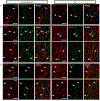Traumatic brain injury recapitulates developmental changes of axons
- PMID: 35870679
- PMCID: PMC9454890
- DOI: 10.1016/j.pneurobio.2022.102332
Traumatic brain injury recapitulates developmental changes of axons
Abstract
During development, half of brain white matter axons are maintained for growth, while the remainder undergo developmental axon degeneration. After traumatic brain injury (TBI), injured axons also appear to follow pathways leading to either degeneration or repair. These observations raise the intriguing, but unexamined possibility that TBI recapitulates developmental axonal programs. Here, we examined axonal changes in the developing brain in young rats and after TBI in adult rat. Multiple shared changes in axonal microtubule (MT) through tubulin post-translational modifications and MT associated proteins (MAPs), tau and MAP6, were found in both development and TBI. Specifically, degenerating axons in both development and TBI underwent phosphorylation of tau and excessive tubulin tyrosination, suggesting MT instability and depolyermization. Conversely, nearby axons without degenerating morphologies, had increased MAP6 expression and maintenance of tubulin acetylation, suggesting enhanced MT stabilization, thereby supporting survival or repair. Quantitative proteomics revealed similar signaling pathways of axon degeneration and growth/repair, including protein clusters and networks. This comparison approach demonstrates how focused evaluation of developmental processes may provide insight into pathways initiated by TBI. In particular, the data suggest that TBI may reawaken dormant axonal programs that direct axons towards either degeneration or growth/repair, supporting further study in this area.
Keywords: Axon; Developmental axon degeneration; MAP6; Tau; Traumatic brain injury; Tubulin post-translational modifications.
Copyright © 2022 Elsevier Ltd. All rights reserved.
Conflict of interest statement
Competing interests None.
Figures







Similar articles
-
White matter involvement after TBI: Clues to axon and myelin repair capacity.Exp Neurol. 2016 Jan;275 Pt 3:328-333. doi: 10.1016/j.expneurol.2015.02.011. Epub 2015 Feb 16. Exp Neurol. 2016. PMID: 25697845 Review.
-
Sarm1 deletion reduces axon damage, demyelination, and white matter atrophy after experimental traumatic brain injury.Exp Neurol. 2019 Nov;321:113040. doi: 10.1016/j.expneurol.2019.113040. Epub 2019 Aug 21. Exp Neurol. 2019. PMID: 31445042
-
Partial interruption of axonal transport due to microtubule breakage accounts for the formation of periodic varicosities after traumatic axonal injury.Exp Neurol. 2012 Jan;233(1):364-72. doi: 10.1016/j.expneurol.2011.10.030. Epub 2011 Nov 4. Exp Neurol. 2012. PMID: 22079153 Free PMC article.
-
Experimental Traumatic Brain Injury Identifies Distinct Early and Late Phase Axonal Conduction Deficits of White Matter Pathophysiology, and Reveals Intervening Recovery.J Neurosci. 2018 Oct 10;38(41):8723-8736. doi: 10.1523/JNEUROSCI.0819-18.2018. Epub 2018 Aug 24. J Neurosci. 2018. PMID: 30143572 Free PMC article.
-
Traumatic Axonal Injury: Mechanisms and Translational Opportunities.Trends Neurosci. 2016 May;39(5):311-324. doi: 10.1016/j.tins.2016.03.002. Epub 2016 Mar 31. Trends Neurosci. 2016. PMID: 27040729 Free PMC article. Review.
Cited by
-
Models of traumatic brain injury-highlights and drawbacks.Front Neurol. 2023 Jun 15;14:1151660. doi: 10.3389/fneur.2023.1151660. eCollection 2023. Front Neurol. 2023. PMID: 37396767 Free PMC article. Review.
-
Neuroinflammation: An Oligodendrocentric View.Glia. 2025 Jun;73(6):1113-1129. doi: 10.1002/glia.70007. Epub 2025 Mar 10. Glia. 2025. PMID: 40059542 Review.
-
Sex differences in the extent of acute axonal pathologies after experimental concussion.Acta Neuropathol. 2024 May 5;147(1):79. doi: 10.1007/s00401-024-02735-9. Acta Neuropathol. 2024. PMID: 38705966 Free PMC article.
-
Advances in neuroproteomics for neurotrauma: unraveling insights for personalized medicine and future prospects.Front Neurol. 2023 Nov 22;14:1288740. doi: 10.3389/fneur.2023.1288740. eCollection 2023. Front Neurol. 2023. PMID: 38073638 Free PMC article. Review.
-
Neuronal tau pathology worsens late-phase white matter degeneration after traumatic brain injury in transgenic mice.Acta Neuropathol. 2023 Oct;146(4):585-610. doi: 10.1007/s00401-023-02622-9. Epub 2023 Aug 14. Acta Neuropathol. 2023. PMID: 37578550 Free PMC article.
References
-
- Bagri A, Cheng HJ, Yaron A, Pleasure SJ, Tessier-Lavigne M, 2003. Stereotyped pruning of long hippocampal axon branches triggered by retraction inducers of the semaphorin family. Cell 113, 285–299. - PubMed
Publication types
MeSH terms
Substances
Grants and funding
LinkOut - more resources
Full Text Sources
Medical

